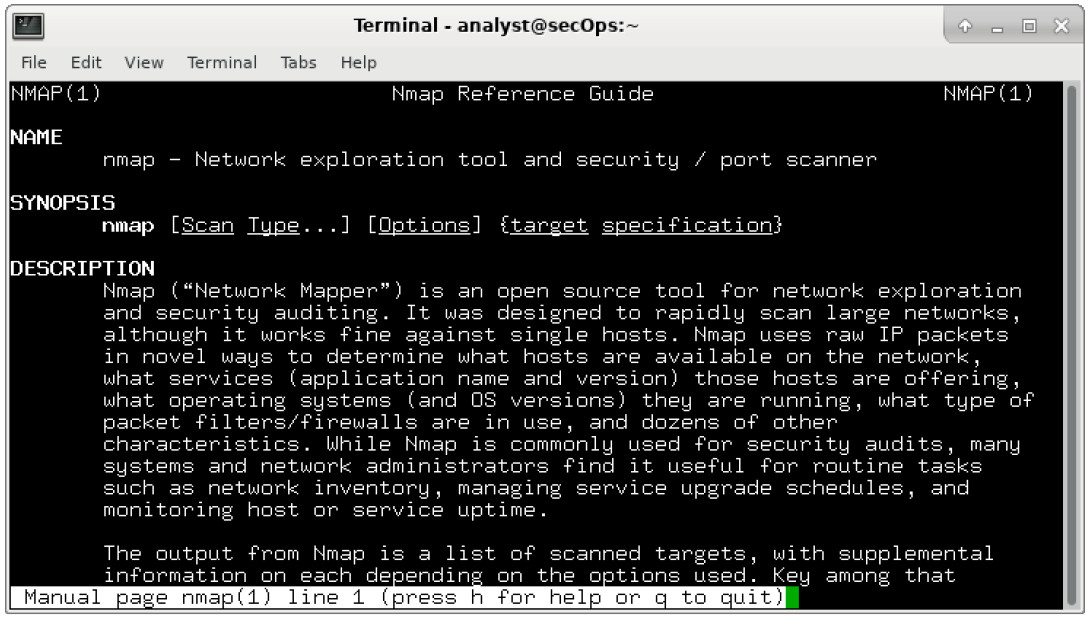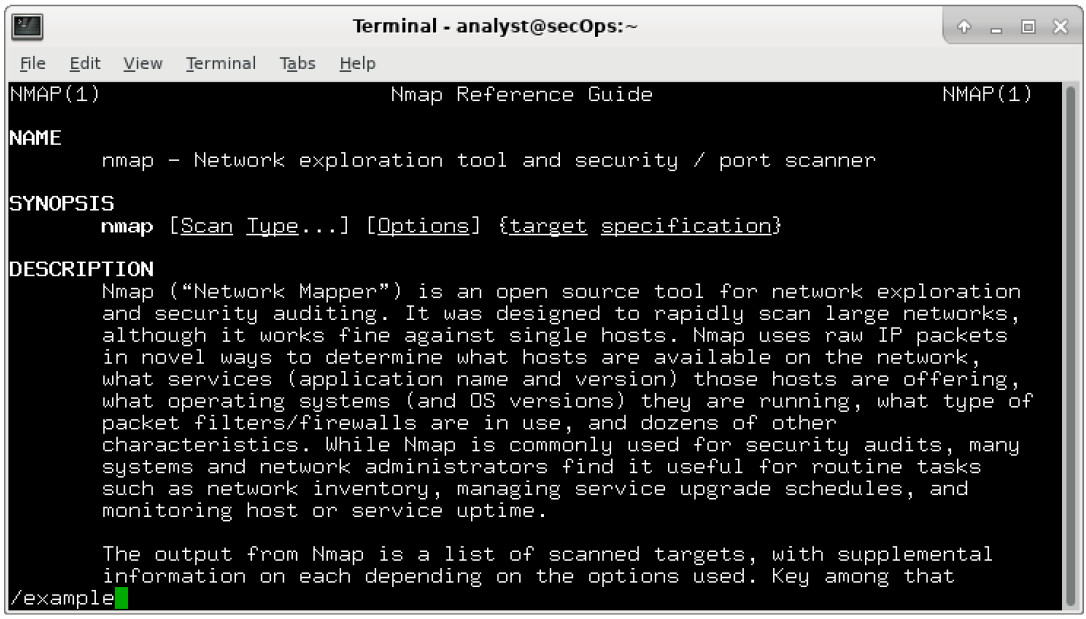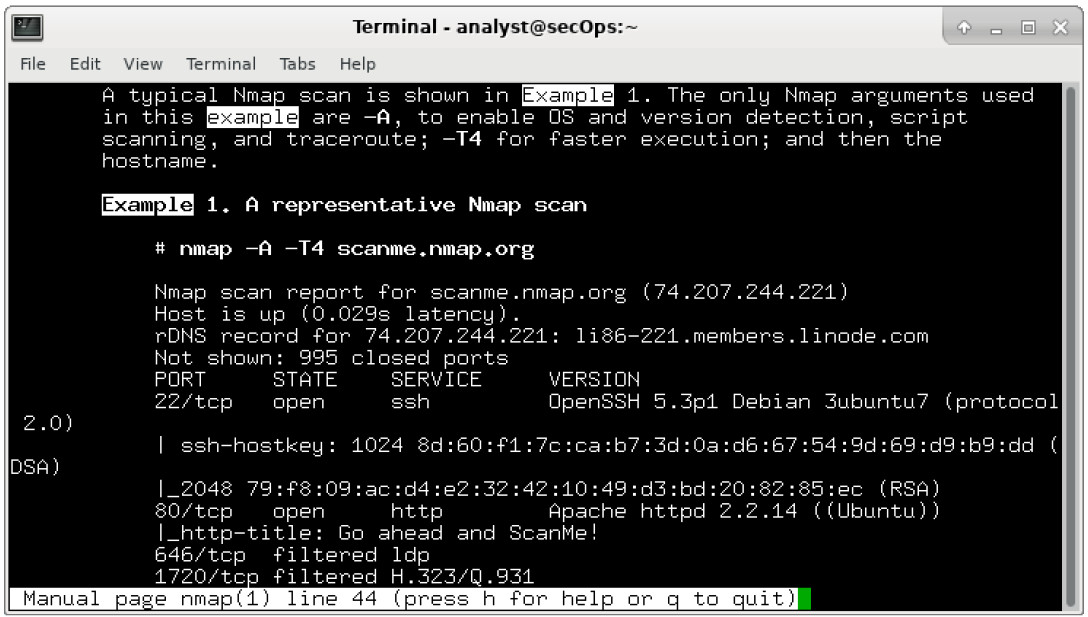Topology

Objectives
- Part 1: Exploring Nmap
- Part 2: Scanning for Open Ports
Background / Scenario
Port scanning is usually part of a reconnaissance attack. There are a variety of port scanning methods that can be used. We will explore how to use the Nmap utility. Nmap is a powerful network utility that is used for network discovery and security auditing.
Required Resources
- CyberOps Workstation Virtual Machine
- Internet access
Part 1: Exploring Nmap
In this part, you will use manual pages (or man pages for short) to learn more about Nmap.
The man [ program |utility | function] command displays the manual pages associated with the arguments.
The manual pages are the reference manuals found on Unix and Linux OSs. These pages can include these sections: Name, Synopsis, Descriptions, Examples, and See Also.
a. Start CyberOps Workstation VM.
b. Open a terminal.
c. At the terminal prompt, enter man nmap.
[analyst@secOps ~]$ man nmap

What is Nmap?
Nmap is a network exploration tool and security / port scanner.
What is nmap used for?
Nmap is used to scan a network and determine the available hosts and services offered in the network. Some of the nmap features include host discovery, port scanning and operating system detection. Nmap can be commonly used for security audits, to identify open ports, network inventory, and find vulnerabilities in the network.
d. While in the man page, you can use the up and down arrow keys to scroll through the pages. You can also press the space bar to forward one page at a time.
To search for a specific term or phrase use enter a forward slash (/) or question mark (?) followed by the term or phrase. The forward slash searches forward through the document, and the question mark searches backward through the document. The key n moves to the next match.
Type /example and press ENTER. This will search for the word example forward through the man page.

e. In the first instance of example, you see three matches. To move to the next match, press n.

Look at Example 1. What is the nmap command used?
Nmap -A -T4 scanme.nmap.org
Use the search function to answer the following questions.
What does the switch -A do?
-A: Enable OS detection, version detection, script scanning, and traceroute
What does the switch -T4 do?
-T4 for faster execution by prohibiting the dynamic scan delay from exceeding 10 ms for TCP ports. -T4 is recommended for a decent broadband or ethernet connection.
f. Scroll through the page to learn more about nmap. Type q when finished.
Part 2: Scanning for Open Ports
In this part, you will use the switches from the example in the Nmap man pages to scan your localhost, your local network, and a remote server at scanme.nmap.org.
Step 1: Scan your localhost.
a. If necessary, open a terminal on the VM. At the prompt, enter nmap -A -T4 localhost. Depending on your local network and devices, the scan will take anywhere from a few seconds to a few minutes.
[analyst@secOps Desktop]$ nmap -A -T4 localhost Starting Nmap 7.40 ( https://nmap.org ) at 2017-05-01 17:20 EDT Nmap scan report for localhost (127.0.0.1) Host is up (0.000056s latency). Other addresses for localhost (not scanned): ::1 rDNS record for 127.0.0.1: localhost.localdomain Not shown: 996 closed ports PORT STATE SERVICE VERSION 21/tcp open ftp vsftpd 2.0.8 or later | ftp-anon: Anonymous FTP login allowed (FTP code 230) |_-rw-r--r-- 1 0 0 0 Apr 19 15:23 ftp_test 22/tcp open ssh OpenSSH 7.4 (protocol 2.0) | ssh-hostkey: | 2048 f1:61:50:02:94:ba:f2:bd:be:93:cf:14:58:36:b8:32 (RSA) |_ 256 94:33:25:a5:0e:02:d7:bc:c8:b0:90:8a:a2:16:59:e5 (ECDSA) 23/tcp open telnet Openwall GNU/*/Linux telnetd 80/tcp open http nginx 1.12.0 |_http-server-header: nginx/1.12.0 |_http-title: Welcome to nginx! Service Info: Host: Welcome; OS: Linux; CPE: cpe:/o:linux:linux_kernel Service detection performed. Please report any incorrect results at https://nmap.org/submit/ . Nmap done: 1 IP address (1 host up) scanned in 18.81 seconds
b. Review the results and answer the following questions.
Which ports and services are opened?
21/tcp: ftp, 22/tcp: ssh, 23/tcp: telnet, 80/tcp: http
For each of the open ports, record the software that is providing the services.
ftp: vsftpd, ssh: OpenSSH, Telnet: Openwall, http: gninx
What is the operating system?
Linux
Step 2: Scan your network.
Warning: Before using Nmap on any network, please gain the permission of the network owners before proceeding.
a. At the terminal command prompt, enter ifconfig to determine the IP address and subnet mask for this host. For this example, the IP address for this VM is 192.168.1.19 and the subnet mask is 255.255.255.0.
[analyst@secOps ~]$ ifconfig
enp0s3: flags=4163<UP,BROADCAST,RUNNING,MULTICAST> mtu 1500
inet 192.168.1.19 netmask 255.255.255.0 broadcast 192.168.1.255
inet6 fe80::997f:9b16:5aae:1868 prefixlen 64 scopeid 0x20<link>
ether 08:00:27:c9:fa:a1 txqueuelen 1000 (Ethernet)
RX packets 34769 bytes 5025067 (4.7 MiB)
RX errors 0 dropped 0 overruns 0 frame 0
TX packets 10291 bytes 843604 (823.8 KiB)
TX errors 0 dropped 0 overruns 0 carrier 0 collisions 0
device interrupt 19 base 0xd000
Record the IP address and subnet mask for your VM. Which network does your VM belong to?
Answers will vary. This VM has an IP address of 192.168.1.19/24 and it is part of the 192.168.1.0/24 network.
b. To locate other hosts on this LAN, enter nmap -A -T4 network address/prefix. The last octet of the IP address should be replaced with a zero. For example, in the IP address 192.168.1.19, the .19 is the last octet. Therefore, the network address is 192.168.1.0. The /24 is called the prefix and is a shorthand for the netmask 255.255.255.0. If your VM has a different netmask, search the Internet for a “CIDR conversion table” to find your prefix. For example, 255.255.0.0 would be /16. The network address 192.168.1.0/24 is used in this example
Note: This operation can take some time, especially if you have many devices attached to the network. In one test environment, the scan took about 4 minutes.
[analyst@secOps ~]$ nmap -A -T4 192.168.1.0/24 Starting Nmap 7.40 ( https://nmap.org ) at 2017-05-01 17:13 EDT Nmap scan report for 192.168.1.1 Host is up (0.0097s latency). Not shown: 996 closed ports PORT STATE SERVICE VERSION 21/tcp open ftp Bftpd 1.6.6 53/tcp open domain dnsmasq 2.15-OpenDNS-1 | dns-nsid: | id.server: |_ bind.version: dnsmasq-2.15-OpenDNS-1 80/tcp open tcpwrapped | http-auth: | HTTP/1.0 401 Unauthorizedx0D |_ Basic realm=NETGEAR WNR3500Lv2 |_http-title: 401 Unauthorized 5000/tcp open tcpwrapped Service Info: Host: 192.168.1.1 Nmap scan report for 192.168.1.19 Host is up (0.00016s latency). Not shown: 996 closed ports PORT STATE SERVICE VERSION 21/tcp open ftp vsftpd 2.0.8 or later | ftp-anon: Anonymous FTP login allowed (FTP code 230) |_-rw-r--r-- 1 0 0 0 Apr 19 15:23 ftp_test 22/tcp open ssh OpenSSH 7.4 (protocol 2.0) | ssh-hostkey: | 2048 f1:61:50:02:94:ba:f2:bd:be:93:cf:14:58:36:b8:32 (RSA) |_ 256 94:33:25:a5:0e:02:d7:bc:c8:b0:90:8a:a2:16:59:e5 (ECDSA) 23/tcp open telnet Openwall GNU/*/Linux telnetd 80/tcp open http nginx 1.12.0 |_http-server-header: nginx/1.12.0 |_http-title: Welcome to nginx! Service Info: Host: Welcome; OS: Linux; CPE: cpe:/o:linux:linux_kernel <some output omitted> Service detection performed. Please report any incorrect results at https://nmap.org/submit/ . Nmap done: 256 IP addresses (5 hosts up) scanned in 34.21 seconds
How many hosts are up?
Answers will vary.
From your Nmap results, list the IP addresses of the hosts that are on the same LAN as your VM. List some of the services that are available on the detected hosts.
Answers will vary.
Step 3: Scan a remote server.
a. Open a web browser and navigate to scanme.nmap.org. Please read the message posted. What is the purpose of this site?
This site allows users to learn about Nmap and test their Nmap installation.
b. At the terminal prompt, enter nmap -A -T4 scanme.nmap.org.
[analyst@secOps Desktop]$ nmap -A -T4 scanme.nmap.org Starting Nmap 7.40 ( https://nmap.org ) at 2017-05-01 16:46 EDT Nmap scan report for scanme.nmap.org (45.33.32.156) Host is up (0.040s latency). Other addresses for scanme.nmap.org (not scanned): 2600:3c01::f03c:91ff:fe18:bb2f Not shown: 992 closed ports PORT STATE SERVICE VERSION 22/tcp open ssh OpenSSH 6.6.1p1 Ubuntu 2ubuntu2.8 (Ubuntu Linux; protocol 2.0) | ssh-hostkey: | 1024 ac:00:a0:1a:82:ff:cc:55:99:dc:67:2b:34:97:6b:75 (DSA) | 2048 20:3d:2d:44:62:2a:b0:5a:9d:b5:b3:05:14:c2:a6:b2 (RSA) |_ 256 96:02:bb:5e:57:54:1c:4e:45:2f:56:4c:4a:24:b2:57 (ECDSA) 25/tcp filtered smtp 80/tcp open http Apache httpd 2.4.7 ((Ubuntu)) |_http-server-header: Apache/2.4.7 (Ubuntu) |_http-title: Go ahead and ScanMe! 135/tcp filtered msrpc 139/tcp filtered netbios-ssn 445/tcp filtered microsoft-ds 9929/tcp open nping-echo Nping echo 31337/tcp open tcpwrapped Service Info: OS: Linux; CPE: cpe:/o:linux:linux_kernel Service detection performed. Please report any incorrect results at https://nmap.org/submit/ . Nmap done: 1 IP address (1 host up) scanned in 23.96 seconds
c. Review the results and answer the following questions.
Which ports and services are opened?
22/tcp: ssh, 9929/tcp: n ping-echo, 31337/tcp: tcpwrapped, 80/tcp: http
Which ports and services are filtered?
135/tcp: msrpc, 139/tcp: netbios-ssn, 445/tcp: microsoft-ds, 25/tcp: smtp
What is the IP address of the server?
IPv4 address: 45.33.32.156 IPv6 address: 2600:3c01::f03c:91ff:fe18:bb2f
What is the operating system?
Ubuntu Linux
Reflection
Nmap is a powerful tool for network exploration and management. How can Nmap help with network security?
How can Nmap be used by a threat actor as a nefarious tool?
Nmap can be used to scan an internal network for specific open ports to identify the extent of a security breach. It can also be used to inventory a network to ensure that all the systems are probably patched against security concerns. On the other hand, nmap can be used for reconnaissance to determine open ports and other information about the network.
